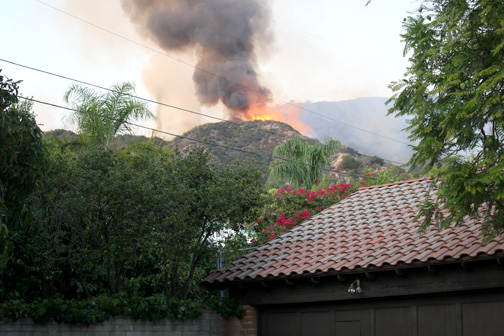
By Mary O’KEEFE
As the vegetation gets drier and drier, thanks to the long lasting drought, firefighters are keeping an ever-watchful eye on the hills that surround Crescenta Valley.
It was six years ago that the Angeles National Forest was on fire and neighborhoods in Crescenta Valley, La Cañada Flintridge and Sunland-Tujunga were evacuated.
On Aug. 26, 2009 what was thought to be a small brush fire grew into the Station Fire, one of the largest wildfires in California history and the largest fire in L.A. County’s recorded history, according to the U.S. Dept. of Agriculture, Forest Service. By the time the fire was contained on Oct. 16 it had burned 161,189 acres of the ANF and had cost the lives of two Los Angeles County firefighters.
On Aug. 31, 2009, L.A. Fire Capt. Tedmund “Ted” Hall, 47, and Specialist Arnaldo Quinones, 34, drove off the side of a mountainous road near inmate Camp 16 near Mt. Gleason. The correction workers, fire personnel and inmates were trapped by fire and the two firefighters were attempting to find safe passage out of the area.
“During the Station Fire, [firefighters] who were here said they have never seen anything like it before,” said Capt. Didier Conrad, LACoFD Station 63.
The Station Fire cleared a lot of the vegetation in the ANF but that does not mean the area can’t burn again.
L.A. County Fire has been conducting abatement of local homes and most residents have complied. Abatement is the clearing of vegetation and anything else that may fuel fire close to homes.
“A few properties need work,” said Capt. Didier Conrad.
The fire department works with residents in regard to abatement; however, if a homeowner does not appear to be attempting to clear the area, fines can be levied.
The clearing is to give firefighters defensible space. It helps both the firefighters and the homeowner.
“What abatement does is give the home an extra buffer zone,” Conrad said.
Conrad added that fighting fires is about safety first, for the firefighter and the homeowners.
“This season we are facing so many fires, from here to Alaska,” he said. “If you talked to [LACoFD] pilots, they have never seen anything like this … It is [so] dry.”
According to the National Interagency Fire Center, at present there are 30,000 wildland firefighters and support personnel fighting fires in 10 states.
As of Wednesday there were six wildfires in the state of California. So far 252,865 acres have burned from those fires.
Nationwide year-to-date, 59 firefighters have lost their lives in the line of duty, according to the U.S. Fire Administration.
“There seems to be larger fires,” Conrad said.
Dry conditions and more homes that interface with wilderness seem to be adding to dangerous fire conditions.
Every day firefighters monitor weather reports and watch the hills. Conrad said ANF has burned and the vegetation is dry, but much less so than six years ago.
“The hills behind us, the Verdugos haven’t burned,” he added. The last time the Verdugo Mountains in the Glendale area burned was in 2002.
Conrad reminds residents to be prepared for fire, especially in case of evacuation, and to make certain to keep roadways clear so firefighters can do their job.
He added that at the Calgrove Fire in Santa Clarita in June, firefighters were delayed because of the traffic on the streets. And, again, firefighters were delayed in July during the brush fire that jumped onto the Cajon Pass igniting vehicles. Some drivers were evacuating the area while others stopped to shoot photos and videos.
“We can’t get to the [fire] if we can’t drive on the streets,” he said.
For information on being proactive regarding fires, visit www.fire.lacounty.gov.
